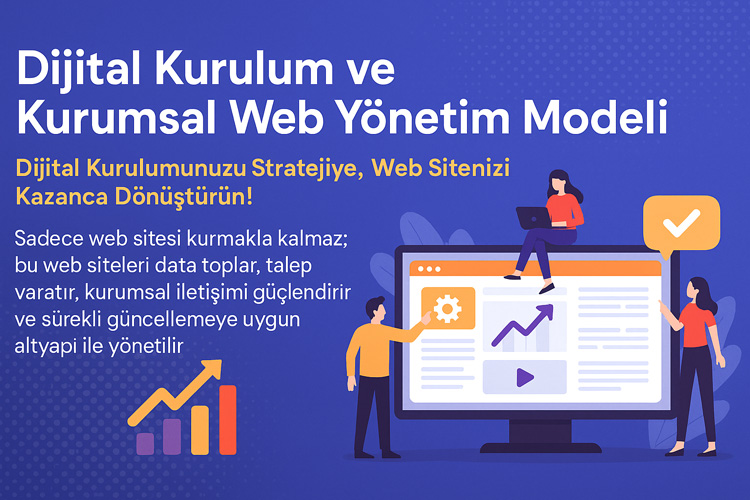Digital Tools are not just software or solutions for today’s businesses; they are strategic investments that transform business processes. Choosing these tools incorrectly can lead to much more than wasted time and money; it can lead to a loss of competitive advantage. So, which tool should we choose from hundreds of options, and why? Moreover, each one comes with technical promises like APIs, integrations, and cloud architecture…
In this article, we will explain all the steps to consider when selecting digital tools in line with the Digital Installation Model, along with examples and strategic recommendations. We’ll share 7 powerful recommendations that will guide you to the right tool by evaluating API compatibility, data security, user experience, maintenance costs, and more.
🧩 You shouldn’t just choose technology; you should choose strategic partners that fit your business. Because digital transformation is as powerful as the tools you choose. If you’re prepared, you won’t lose your way in the digital labyrinth anymore.

İçindekiler
ToggleClarify Your Needs: Not All Software Is Good
The biggest mistake when choosing digital tools is making a decision without fully defining what you expect from the tool. However, every tool is designed to solve a specific problem and serve a specific function. Some are optimized to speed up sales processes, while others aim to reduce costs in the production line. If you choose a tool without defining your needs, you’ll end up purchasing a technologically advanced product without contributing to your business. Therefore, the first step in selecting digital tools is to accurately define the problem. Otherwise, the “most popular tool” may not be the right choice for you.
What do you want to solve for your business? Reducing operational overhead, improving customer experience, or making reporting more efficient? The clearer your goal, the more accurate your tool selection will be. This is where the Digital Installation Model™ provides a systematic approach to the needs analysis process. It transforms the process into a strategic decision, not just a technical one. 🧠
What Problem Do You Want to Solve?
This is the most important question to ask before purchasing any digital tools. If you don’t define the problem correctly, your solution will be incomplete.
Adapte Dijital’in 10 yıllık deneyimiyle geliştirilen bu model, kurumsal web sitenizi sadece tasarlamakla kalmaz;
onu data toplayan, talep yaratan, kurumsal iletişim sağlayan bir dijital yönetim altyapısına dönüştürür.
Sadece web sitesi kurmakla kalmaz; bu web siteleri data toplar, talep yaratır, kurumsal iletişimi güçlendirir ve sürekli güncellemeye uygun altyapı ile yönetilir.
Goal Setting and Functions That Serve the Goal
Digital tools shouldn’t just work well; they should serve your goal. In this respect, digital tools should have functions that align with the business goal.
Process-Focused Thinking Habit
Analyze your business processes to clarify the need. Which stage is congested? Which process has a high manual workload?
Focus on Need Over Popularity
A widely used piece of software may not be suitable for you. When evaluating digital tools, the priority is matching the needs, not the brand.
Question the API and Integration Capabilities of Digital Tools
Today, standalone systems can’t keep up with the speed and flexibility of businesses. Can the digital tools you choose integrate with your other software? The answer to this question directly impacts your business’s digital workflow. API (Application Programming Interface) support is critical, especially for SMEs that use different software such as sales, accounting, production, and human resources. Because a tool without integration capabilities invites data duplication, manual entry overhead, and errors.
A good Digital Installation Model brings integration into the pre-installation planning phase. It evaluates not only what the tools do individually, but how they work together. This ensures that all your business’s data flows and synchronizes within a single digital ecosystem. 🔁
Why is API Support Important?
API support enables data flow between software. This reduces manual processes and makes efficient use of time and human resources.
Create an Integration Map
Plan in advance how the tools you will use will connect to each other. This map prevents disruptions in digital processes.
Single Entry – Multiple Use System
Entering data once and using it across all systems increases efficiency. This is only possible with integration.
Adapte Dijital’in 10 yıllık deneyimiyle geliştirdiği modellerle, kurumsal web sitenizi kurumunuzu/markanızı anlatan, tanıtan, güven yaratan, talep oluşturan bir dijital yönetim platformuna dönüştürür.
Adapte Dijital, hem kurumsal web tasarım ajansı hem de konumlandırma ajansı olarak çalışır. Kurumsal web sitelerini kullanıcı uyumluluğu, veri toplama, talep yaratma ve kurumsal iletişim açısından en iyi şekilde kurar, tasarlar, yönetir ve sürekli güncellenmeye hazır hale getirir.
Integration Costs and Challenges
Not every digital tool integrates with every software. Therefore, you should know the integration time, cost, and technical support criteria from the outset.
Does Digital Infrastructure Investment Provide a Return? Analysis with Real Data
Prefer Software with API Integration
In the digital transformation process, not only functional software but also interoperable software should be preferred. Data synchronization via API should be ensured, particularly between business-critical applications such as sales, CRM, ERP, and accounting. This reduces manual labor in digital processes, increases data consistency, and saves time. Integratable software helps your business achieve a holistic digital structure because it can communicate with different systems.
The Digital Installation Model prioritizes tools with high integration capabilities in software selection. This creates an infrastructure that supports not only today but also future expansions. While software with limited integration capabilities isolates your business, integrated solutions make your business a part of ecosystems. 🌐
Which Platforms is it Compatible with?
Can the software you want to use integrate with the systems you already use? For example: Like Excel, SAP, Logo, Mikro, Netsis, Google Workspace.
Integration into Automation Processes
Thanks to the API, not only data flow but also task automation can be achieved. Tasks such as automatic invoice sending, data analysis, or report generation can be integrated.
Teams Providing Integration Support
Check whether your chosen software provider offers technical support for API integration. You shouldn’t be left alone after installation.
Security Measures in Integrated Systems
API integrations must be provided with secure access protocols. Authentication and authorization are essential to prevent data leakage to the wrong parties.
Preparing for 2025 with the Digital Installation Model: Integration, Automation, and More
Industry Compatibility: Is Every Tool Suitable for Every Field?
One of the most common mistakes made during the digitalization process is using digital tools that aren’t suitable for every industry. Workflows, regulations, and user behaviors vary, especially in areas like manufacturing, healthcare, logistics, and retail. Therefore, the digital solutions chosen should offer not only general functionality but also features specific to industry needs. For example, while HIPAA compliance is required for patient data security in the healthcare sector, inventory management andCustomer experience-focused systems should be preferred.
The Digital Installation Model aims to help businesses transition to digital with the right tools by offering industry-specific solutions. This ensures a transformation that aligns not only with technology but also with the nature of business processes. 🎯
Industry-Specific Software
Every industry has a different operational rhythm. For example; While automation is at the forefront in the manufacturing sector, customer management is more critical in the service sector.
Legislation and Regulation Compliance
The tools you choose should comply with the legal requirements of your industry. Otherwise, the digitalization process could pose legal risks.
Terminology and Interface Compatibility
Industry-appropriate interfaces and conceptual designs facilitate adaptation by supporting user habits.
Integration Potential
It is a great advantage for the industry-specific software you use to be integrated with other support systems. API compatibility plays a decisive role here again.
Balancing Cost and Return in Digital Tool Selection
Digitalization investment is not just an investment in technology; it is a strategic step that provides long-term efficiency, speed, and competitive advantage. However, for SMEs, every cost item requires a delicate balance. At this point, the license cost, installation fees, training needs, and maintenance expenses of digital tools should be analyzed in detail. Because without proper analysis, investments can be made in high-cost but low-return systems.
The Digital Installation Model provides concrete indicators to determine how much budget SMEs should allocate to each tool. It focuses not only on price-performance, but also on the return on investment (ROI) and operational efficiency. This allows for “right, not expensive” technology investments. 📊

Total Cost of Ownership (TCO) Calculation
In addition to the software license fee, post-installation support and maintenance costs should also be taken into account.
Long-Term Savings Potential
While digital solutions may seem like a short-term expense, they save time and effort in the long run.
Return Time (ROI) Tracking
A clear plan should be made regarding how long it will take for the installed system to pay for itself. This data can reshape investment decisions.
Unused Features = Waste
Paying extra for unneeded or unused system modules means wasting your budget.
How to Create a Corporate Digitalization Strategy? (From A to Z)
Strategic Approach to Selecting Digital Tools
One of the most important questions SMEs face during the digitalization process is which digital tools to use.The key is determining the tools to be used and how well they align with business objectives. At this point, digital tools should be considered not just as technology investments but also as levers of corporate transformation. If the right tools are not selected, system integration becomes difficult, user adoption is delayed, and the return on investment decreases. Therefore, the digital tool selection process should be a strategic corporate decision, not an impromptu purchase.
Identifying digital tools that align with corporate goals means progressing in a way that addresses not only current needs but also future growth plans. The principle of “process first, then technology” is a critical guideline at this point. Before selecting a tool, an infrastructure map aligned with the digital installation model should be created, and then the tools suitable for this infrastructure should be identified. Every digital tool should address a process inefficiency or add direct value to the user. Otherwise, tools become mere “technological accessories,” and the goal of corporate digitalization is lost.
Determining Functionality and Compatibility Criteria
The first step in selecting digital tools is to clearly define the need. SMEs often choose similar software simply because they are popular in the market. However, every business has a different structure, growth goals, and business processes. Therefore, the functionality of the tools should be compatible with the company’s organizational structure, workflow, and employee profile. A tool should not only be useful but also integrate seamlessly with existing systems.
For example, a CRM software should not only record sales data but also integrate with the ERP system to enable cross-analysis with financial data. This requires technical features such as API support, cloud architecture, and multi-user experience to be considered when selecting a tool. The tools selected should meet today’s needs while also being able to adapt to future growth scenarios.
Scalability and Adaptability to Growth
Scalability is perhaps one of the most critical factors in selecting digital tools for SMEs. A company operating with a team of 10 today could grow to 50 within two years. If the selected system isn’t flexible enough to accommodate this growth, it may have to be completely replaced within a few years. This leads to both a waste of resources and constant disruptions to employee onboarding.
Therefore, features that indicate scalability, such as modular structure, user license flexibility, remote access, multi-language support, and extensible API infrastructure, should be considered. The software provider’s support services, update policy, and integration processes should also be included in the evaluation list. Remember, digitalization is not a one-time investment, but a continuously evolving strategy.
Training and Adaptation Support
No matter how powerful the technology, success cannot be achieved unless users adapt. Therefore, the digital tools SMEs choose should be compatible not only with technical but also with human-centered adaptation processes. User-friendly interfaces, modules that shorten the learning curve, and localized content are key in this context.
However, another factor that is just as important is the training and support package offered by the software provider. Not only completing the installation, but also ensuring active and effective use by staff is a part of digitalization. Therefore, when choosing Digital Tools, comprehensive onboarding processes, live support, and frequently updated knowledge repositories should definitely be considered.
Cost and Return on Investment (ROI)
The price of Digital Tools does not determine its cost; in fact, the total cost of ownership (TCO) and return on investment (ROI) should be considered together. Many SMEs make the wrong choice by focusing solely on license fees. However, hidden costs—application consulting, adoption, support requests, training expenses—are the total cost.The cost becomes the determining factor.
Within the Digital Installation Model, the contributions digital tools make to business processes and the time and resource savings they provide through increased efficiency should be measured, and these values should be supported by concrete data. Tools purchased without ROI calculations simply become an expense. Therefore, cost analysis should be conducted not only with a current but also with a 12–24-month return projection. Tools without high ROI are a sign of stagnation, not digitalization.
How Do SMEs Start Digital Transformation? 5+1 Compliant Roadmap
Advantages of Integration with Cloud-Based Systems
Cloud-based systems have become a cornerstone of modern digital infrastructures. These structures, which offer flexible, scalable, and accessible solutions without relying on traditional servers, enable companies to adapt much faster, especially with API integrations. The Digital Installation Model prioritizes working with cloud-based systems, supporting companies to achieve more efficient results in terms of both cost and time. Thanks to cloud infrastructures, technical details such as software updates, maintenance operations, and data backups are automated, reducing the burden on IT teams. It’s also possible to provide real-time synchronization between different applications.
Another key advantage of these systems is the ease of remote access and collaboration. Teams in different cities or countries can access the same system simultaneously, view data simultaneously, and make decisions quickly. Furthermore, thanks to their scalable structure, cloud-based solutions easily keep pace with company growth. The absence of physical server costs and payment only for the resources used also provide a significant financial advantage for SMEs. Let’s examine the critical advantages of this integration under four main headings.
Flexibility and Scalability: Using Resources According to Need
The greatest strength of cloud systems is their flexibility. You can increase resources when traffic increases and reduce them when needs decrease. This prevents systems from crashing, especially during campaigns, seasonal peaks, or times of crisis. It also provides the opportunity for growth without investing in physical infrastructure. The Digital Installation Model, in particular, utilizes this flexibility to its fullest extent, analyzing the integration needs of different departments in advance and dynamically allocating resources. This avoids unnecessary investment costs and increases efficiency.
Automated Updates and Maintenance
Another important benefit of cloud infrastructures is the automation of software updates and system maintenance. In traditional systems, these processes take time and sometimes lead to service interruptions. However, cloud-based solutions perform maintenance in the background, ensuring seamless system operation. This increases operational continuity. Furthermore, the Digital Installation Model securely aligns integration points with automatic updates. This means that updates to one application won’t negatively impact other applications.
Ease of Access and Remote Work Support
In the post-pandemic era, remote access has become a necessity in digital systems. Cloud-based systems, along with geographic independence, enable employees to securely access systems from anywhere. This ease of access is a significant advantage, especially for different departments and branches. Furthermore, thanks to data synchronization, everyone can access the most up-to-date information simultaneously. The Digital Installation Model provides structures that provide this flexibility.Because it’s designed to be compatible with Windows 10, it establishes a strong digital backbone that supports remote working.
Cost Advantage and Resource Savings
High expenses for physical servers, licenses, and maintenance create a significant burden on traditional systems. However, because cloud-based systems operate on a pay-as-you-go model, budget planning can be more transparent and controlled. Furthermore, since no hardware investment is required, capital expenses are reduced. This is particularly important for small and medium-sized businesses. The Digital Installation Model optimizes the integration structure built over cloud architecture not only with technical but also financial strategies. This results in a faster return on investment.
What is API Integration and Why is It Important?
Digital tools enable businesses to go beyond individual software and collaborate in their digital transformation processes. APIs (Application Programming Interfaces), the cornerstone of this integration, enable data exchange between digital tools. Thanks to API integration, your accounting software can communicate with your inventory management system; your CRM application can synchronize with email automations. While manual data entry and repetitive tasks can lead to both time and cost losses, especially for SMEs, this workload is minimized thanks to API-integrated digital tools. Increased automation reduces error rates and accelerates workflow 🚀
API integration represents not only the technical compatibility of systems but also the strategic integrity of processes. Integration bridges established between all digital tools a business uses ensure consistent and up-to-date data flow within the organization. This directly impacts decision-making processes. For example, having customer data accessible from sales teams to marketing on the same platform not only saves time but also creates a holistic customer experience. API systems, properly integrated with digital tools, completely transform business practices.

Basic Features of API-Powered Digital Tools
Digital tools that work via API ensure data transfer in accordance with open standards. Thanks to structures like REST, JSON, and SOAP, one tool can connect to another very quickly. These integrations have become easy and cost-effective enough to be accessible not only to large companies but also to SMEs. A digital tool with a powerful API; It can be customized, integrated with different systems, and offers flexible solutions over time. Therefore, API documentation and support levels should be carefully reviewed when making a selection.
Points to Consider in an Integration Strategy
Not every digital tool is compatible with every system. When planning API integration, the systems with which the digital tools can be integrated should be carefully analyzed. Compatibility, security, and data integrity are the three most important factors. Furthermore, API versioning, maintenance, and error management are critical for the smooth operation of the process. The recommended strategy for SMEs is to select a small but functional set of digital tools and ensure that these tools work integrated with each other.
Advantages of API Integration in Digital Tools
Thanks to API-integrated digital tools, businesses can eliminate manual reporting.This eliminates unnecessary data loss, increases data accuracy, and makes processes more transparent. Data flow between departments, particularly sales, marketing, finance, and logistics, can occur in real time. This allows decision-makers to make faster, more data-driven decisions. At the same time, automation via API reduces staff burden and minimizes errors. In this respect, digital tools enable companies to become more agile.
Practice Recommendations for Successful API Integration
For API integration, first map the existing digital infrastructure, then plan the integration between the tools. Start small and run integration scenarios in a test environment. If the API support offered by a digital tool is insufficient, alternative tools should be considered or custom integration solutions should be developed. API integration, particularly in areas such as ERP, CRM, and e-commerce systems, can significantly improve operational efficiency.
Compatibility of Digital Tools with Cloud Architecture
At the heart of today’s digital transformation, cloud architecture is one of the fundamental building blocks that ensure high adaptability and flexibility among digital tools. From SMEs to large-scale enterprises, businesses are turning to cloud-based digital tools to streamline their processes, establish flexible infrastructures, and optimize costs. Thanks to cloud architecture, software updates, data backups, and maintenance are automated, allowing businesses to focus more on their core business. Most importantly, this structure enables digital tools to work integrated within the same system.
The geographic independence and scalability offered by cloud architecture increases the access speed of digital tools and centralizes data management. Problems such as access issues, insufficient storage, or update difficulties experienced in traditional systems are largely eliminated with cloud-based solutions. This architecture offers businesses the advantage of being ready for not only today’s technologies but also the technologies of the future. When your digital tools are integrated with the cloud, every aspect of your company works synchronously on the same platform. This is one of the most important steps that increases digital maturity ☁️
Ease of Integration of Cloud-Based Tools
Digital tools running on the cloud are much more flexible in terms of API integration. These systems typically have open APIs, extensive integration libraries, and comprehensive developer documentation. This makes it easier to switch and share data between platforms like CRM, ERP, e-commerce, and marketing automation. Furthermore, because most of these tools are offered through a SaaS model, licensing and installation costs are reduced. Large-scale solutions become applicable even for small businesses.
The Role of the Cloud in Data Security and Compliance Processes
Cloud systems offer advanced encryption, multi-layered access control, and continuous auditing mechanisms for data security. This enables businesses working with digital tools to more easily comply with legal obligations such as KVKK and GDPR. Data is not only stored but also continuously protected. Issues such as backup, disaster recovery, and user authorization are managed much more securely in the cloud.
Achieving Resource Efficiency with Cost Advantages
Cloud architecture eliminates the need for physical servers, reducing infrastructure investments. Thanks to models that only pay for resources used, digital tools can deliver high performance with low budgets. This flexibility allows SMEs to use their limited resources more efficiently. At the same time, different departments can operate on the same infrastructure.It can work with different applications and operate on shared data.
Future-Proof Through Scalability
As businesses grow, their need for digital tools and transaction volumes also increases. Cloud architecture easily adapts to this growth. Adding new modules, users, or locations is possible with just a few clicks. This eliminates the need for infrastructure to achieve future digitalization goals. At the same time, when existing systems prove inadequate, businesses can continuously evolve with new integrations provided via the cloud.
The Importance of Sectoral Compatibility in Selecting Digital Tools
Every business’s digital transformation journey is unique; if the digital tools used in this journey are not compatible with the dynamics of the industry, the expected results cannot be achieved. Therefore, the primary criterion in tool selection should be sectoral compatibility. For example, IoT-compatible systems are prioritized for the manufacturing sector, while solutions that provide omnichannel management are prioritized for retail. Tools that meet industry-specific needs not only provide solutions to current problems but also pave the way for future growth. This way, investments quickly pay off, and digitalization progresses unabated.
However, regulations, workflows, user habits, and the competitive landscape differ across sectors. These differences play a decisive role in the selection of digital tools. For example, while compliance with the Personal Data Protection Law (KVKK) is essential in the healthcare sector, data integrity and instant reporting are more important in finance. Wrong choices can lead to system incompatibilities, integration problems, and operational disruptions. Therefore, attention should be paid not only to the general functionality of the tools, but also to their adaptability to specific industry specifics.
Why Are Industry-Appropriate Modules and Feature Sets Important?
The modules within a digital tool should be tailored to industry needs. For example, while functions like reservation tracking and customer loyalty management are critical in the hotel industry, a logistics company should focus on route optimization, vehicle tracking, and delivery performance analysis. Because each industry operates with unique processes, ensuring the chosen tool is ready for this directly impacts operational success.
Can the Digital Tools Used by Competitors Be a Guide?
Competitor analysis provides important data in the digital tool selection process. Understanding which tools are widely used in your industry can also be a guide. However, differentiation is necessary, not just imitation. Even within the same industry, your business practices, scale, and goals may differ. Therefore, while taking inspiration from competitors, the best approach is to choose the tools that best suit your business model.
How Does Regulatory Compliance Affect Digital Tool Selection?
Industry-specific legal regulations can make the use of some digital tools mandatory or even difficult. Especially in highly regulated fields like healthcare, finance, and law, tools must be examined for compliance with standards like KVKK, GDPR, and ISO 27001. Otherwise, legal violations can lead to both fines and loss of customer trust. For this reason, the legal compliance of the tools should be considered as much as their technical competence.
Is it possible to choose the right tool with sector-specific consulting?
Deciding on digital tools alone can lead to wrong choices. At this point, consulting firms with sectoral experience can facilitate the process with accurate guidance. They can help you understand which tools are successful in your sector, which integrations are most effective in your industry, and which ones are most suitable for your needs.Getting expert support on issues like easier operation of systems can save significant time and costs. This support is especially strategic for businesses embarking on digitalization for the first time.
Intercommunication of Digital Tools: Integration Capability
The more digital tools a business uses, the more crucial it becomes for these tools to seamlessly exchange data. Integration is not just a technical connection; it’s a necessary infrastructure for holistic and uninterrupted processes. If data flow between tools is interrupted or manual intervention is required, the purpose of digitalization can be thwarted. Therefore, integration capability should be one of the first criteria considered when selecting a tool.
In businesses that use multiple software simultaneously—for example, if data compatibility between CRM and ERP, e-commerce platforms and inventory tracking, and accounting and invoicing systems isn’t achieved—processes will be delayed and the risk of errors increases. Digital tools should not only fulfill their own functions but also be able to work in sync with other systems. This communication can be strengthened, especially in cloud-based systems, through methods such as API integration.
What Problems Do Non-Integrated Systems Cause?
Non-integrated systems often lead to data duplication, lost time, and human error. For example, if customer data must be entered separately into both the CRM system and the billing software, data inconsistencies are inevitable. This increases both workload and reduces customer satisfaction. Businesses working with integrated systems eliminate such problems from the outset.
Which Integration Methods Are Most Commonly Used?
Modern digital tools generally enable API (Application Programming Interface)-based integrations. Additionally, methods such as webhooks, middleware, and XML/CSV data transfer are also preferred. The method to use depends on the existing infrastructure, the technical specifications of the tools, and the intended use case. However, the core goal is always the same: seamless data flow and operational compatibility.
How Long Does the Integration Process Take?
The integration time varies depending on the project and the technical compatibility of the systems. While a simple CRM-ERP connection can be completed in a few days, a multi-layered digital ecosystem integration can take weeks. When planning the process, analysis, testing, migration, and support phases should be included in the timeline. A good integration plan directly increases a business’s digital efficiency.
How to Measure the Contribution of Integration to Success?
Successful integration demonstrates tangible outcomes such as increased operational efficiency, reduced error rates, and shorter processing times. Customer experience is also positively impacted by this process. When systems work in integration, customer requests are responded to more quickly and processes become more transparent. This way, the business gains strength in both internal processes and external relations.
📌 About This Content
This content was prepared to explain in detail the importance of choosing the right tools and centering the user experience on the digitalization journey. It aims to provide solutions to the fundamental problems faced by many organizations, from SMEs to large-scale enterprises. Throughout the article, every aspect of how digital tools interact with the user, from interface design and accessibility principles to user training and feedback processes, is discussed.
At Adapte Dijital, we support organizations’ digital transformation processes not only with technology, but also with a strategic approach that prioritizes people and process alignment. The user experience and tool selection criteria described in this article are distilled from the solutions we’ve implemented in the field within the framework of the Digital Installation Model™ and the 5+1 Digital Adaptation Plan™.
Furthermore, if you want to promote your digital assets more effectively and strengthen your internal or external communication strategies; You can get professional support with visual, video, and content production services at kurumsaltanitimi.com. We’re here to make your corporate digital assets not just “beautiful,” but also purpose-oriented and user-friendly.
Each piece of content provides a roadmap for leaders who want to build more efficient, accessible, and sustainable digital systems. If you want to lay a solid foundation for your organization’s digital deployment journey, it’s time to take action with the guidance of Adapte Dijital .







